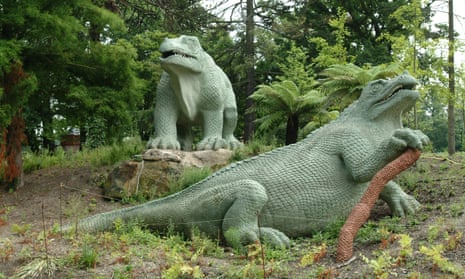
Impossible Monsters by Michael Taylor review – fossil feuds
A marvellous history of science vs creationism in Victorian Britain
During the English civil war, in hiding and in boredom, the Archbishop of Armagh, James Ussher, set about pinning down the date of creation. A decade down the line, he publicised his research findings with breathtaking self-assurance: the world was a sprightly 6,000 years old. More specifically, God had created it on a Saturday night in October 4004BC. As it was, his hunch was a few zeros off the mark. The Earth was, in fact, formed 4.6bn years ago.
Growing up in Ulster’s Bible belt, the historian Michael Taylor writes, Ussher’s chronology was “a matter of regional pride”. Impossible Monsters may not go down especially well back home, then, because its subject is the twin assault on Ussher’s view that came during the 19th century: Charles Lyell’s uniformitarian geology and Charles Darwin’s evolutionary biology.
We begin in 1811, with the 12-year-old Mary Anning chancing on the fossilised remains of an ichthyosaur, a “fish-lizard” with cavernous eye-sockets and a curved snout, on the Dorset coastline. History commemorates her in rhyme – she’s the girl who “sells seashells by the seashore” – but at the time, the implications of her discovery were nothing short of heresy. Surely, if species could go extinct, it followed that Noah had failed to save all of them from the flood?
Greater clarification came in 1824, when the clergyman William Buckland revealed that the gigantic “Scrotum humanum” discovered in 17th-century Oxfordshire was not the private parts of an exceedingly tall man; it was instead the femur of a megalosaurus. Still, teaching as he did at Oxford, that intellectual backwater where incurious dons knocked back staggering amounts of port, Buckland had to tiptoe around the sensibilities of his colleagues, many of them Anglican luminaries.
Much of Taylor’s book is given over to a marvellous reconstruction of the early Victorian thought-world. He ably shows how science struggled to gain a foothold in a suffocatingly, stultifyingly religious society. In the 1830s, the Oxford movement was all the rage. Cosplaying Catholicism, in particular by embracing some rather camp aspects of Roman liturgy, clerics set to work rolling back the excesses of the Reformation. Whigs were derided as woke radicals, science and the abolition of slavery as voguish nonsense.
All the same, the accumulation of evidence was proving impossible to ignore. And when it was spelled out by even so conservative a figure as the barrister turned geologist Charles Lyell, it became pretty clear that science was going to prevail. He had his eureka moment observing the ruined columns of the Macellum of Pozzuoli, near Naples. Their stratified decomposition told a story of changing sea levels, from which Lyell drew the conclusion that geological change was a slow, and gradual, proposition; nothing like what the Bible described.
It was on the strength of this discovery that Lyell assumed the chair in geology at King’s College London, an institution established explicitly as a pious alternative to that “godless college in Gower Street”, University College London. What’s more, Lyell wrote a superbly lucid popular work, Principles of Geology (1830), yanking science out of the ivory tower.
What Lyell achieved in the field of geology, Darwin did in the field of biology. In 1838, a rather outre idea entered his head when he observed Jenny, the famous orangutan at London Zoo who could drink tea from a cup and hold open doors for ladies. Two decades later, he landed the second blow to Ussher’s thesis: On the Origin of Species.
Impossible Monsters is a work of remarkable range. Taylor, a past winner of University Challenge, belongs to that rare class of writers who can effortlessly encompass both scientific arcana and intellectual currents. There are some deliciously provocative passages in this book, such as his argument that the success of phrenology – the racist science of skull shapes – unwittingly produced the conditions in which other anticlerical ideas such as Darwinian evolution could thrive.
after newsletter promotion
It is also to his credit that he every so often takes us away from the high tables to show us what ordinary people made of these huge strides in thinking. When, in a fit of scientific nationalism, model dinosaurs were displayed at Crystal Palace, one confident spectator explained that what happened to those beasts was that they “were too large to go into the Ark, and so they were all drowned”.
Source: theguardian.com



